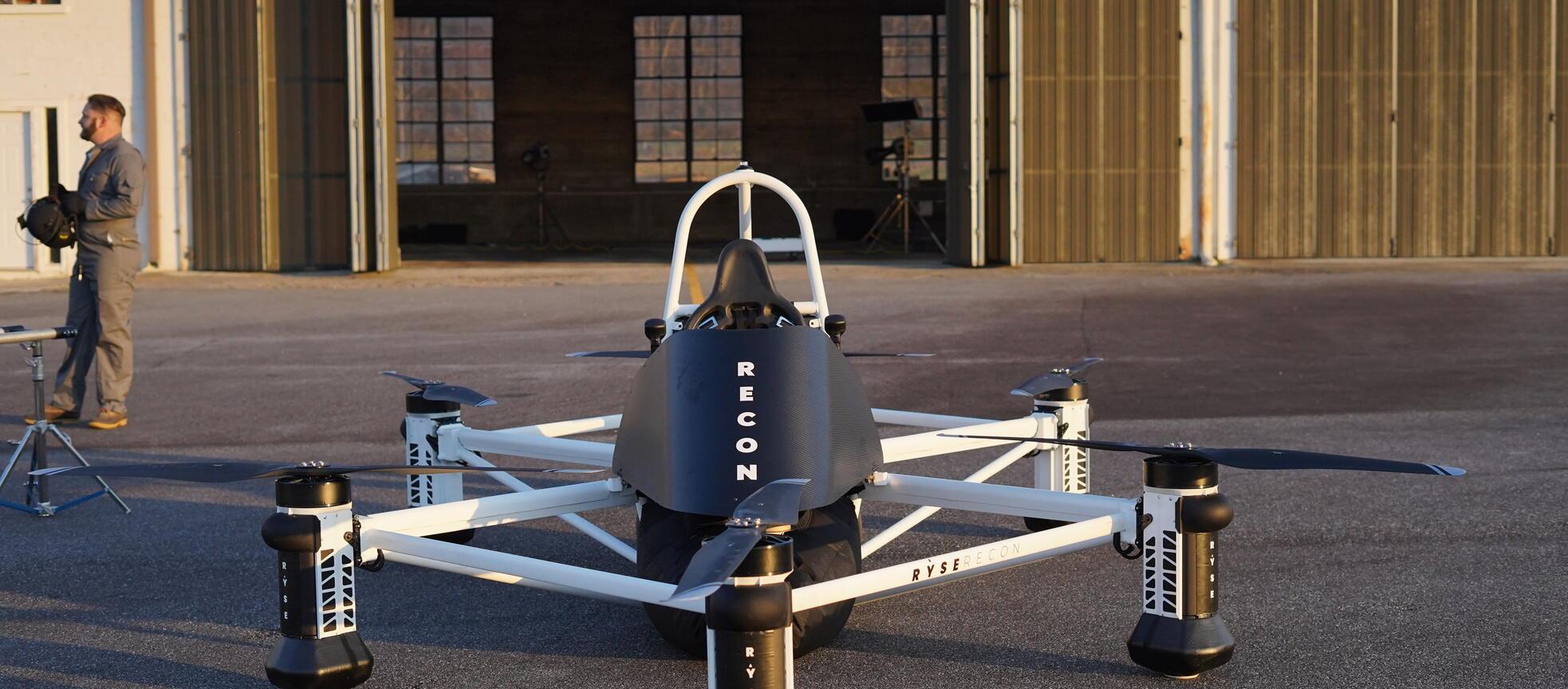
The Ryse Recon can fly up to 25 min. at a top speed of 63 mph.
RYSE Aero Tech is an Ohio-headquartered company developing an electric-vertical-takeoff-and-landing (eVTOL) vehicle for the personal use market, part of a growing wave of startups aiming to sell their aircraft directly to private users under the FAA’s rules for ultralight aircraft.
At 255 lb. gross weight, the RYSE RECON is a multirotor aircraft with a maximum flight time of 25 min., top speed of 63 mph and maximum payload of 250 lb. The aircraft has a relatively simple design with six batteries powering six electric motors, which in turn power the vehicle’s six carbon-blade rotors.
The RECON has an open canopy and is easily controlled by two joysticks with a touchscreen display in the center, reflecting the company’s simplified vehicle operations approach, CEO Mick Kowitz says.
“The idea is that it should be self-stabilizing, it should take care of all the redundancies,” Kowitz tells the AAM Report. “The left stick takes the aircraft up or down, the right stick takes it forward, backward and side to side, and then you’ve got the wheel to give you yaw. It’s really quite simple to fly.”
Under the FAA’s rules for ultralight aircraft, the RECON cannot operate over congested towns, cities or assemblies of people. But Kowitz believes there is a large market for private owners who can fly the aircraft over private properties, wooded areas, national parks or farms. No pilot license or qualification is required to operate the aircraft besides the training provided by the company, which can be completed in an afternoon.
“Right now, ultralights are a $5.5 billion market with a CAGR of 6.7%, and it’s expected to grow to $11.2 billion by 2030,” Kowitz says. “We think it’s really the perfect space, where we can build our eVTOL in a safe and efficient way that does not have to go down that complicated regulatory and certification path.”
Kowitz sees agriculture as a particular application of focus for the RECON, which could help farmers quickly get around and aerially survey their properties. “Farmers are perfect for this because they buy equipment, they know how to maintain equipment, and they’re using it on private land,” he says. “The most valuable thing for a farmer is time, so if we can get them as the crow flies 10 miles out and 10 miles back with our 25-minute range, it’s the perfect fit.”
But the vehicle is also intended for use as a purely recreational sport aircraft that both aviators and nonaviators can enjoy at lower altitudes over nonpopulated areas. “From a personal perspective, I think people flying recreationally, national parks, things like that, there’s absolutely opportunity,” Kowitz says.
As far as safety features, the vehicle is built with six layers of redundancy, with an automatic “Land-Now” function that can be triggered manually by the pilot or automatically by the aircraft’s computer system if a motor goes out or if the vehicle’s battery power gets exhausted.
“It will list a bit, and then it will self-stabilize and you will have enough maneuverability to get down to the ground safely and slowly,” Kowitz says. “More to the point, because our batteries, battery management system and speed controllers are independent–and of course the motor and props are independent–the likelihood of having more than one go out is pretty poor, but if it does, we bring it down safely.”
RYSE Aero Tech is currently building its fourth prototype aircraft, which it describes as a preproduction model. “We’re really close to the production vehicle that we can build over and over again,” Kowitz says.
The company can currently build up to 10 aircraft per month. Once it opens a planned 100,000-sq.-ft. manufacturing facility—with a location yet to be decided—Kowitz envisions a production rate of 100 units per month.
The aircraft has so far amassed between 200 and 250 reservations despite minimal public marketing, according to Kowitz, who said it will carry an initial list price of $150,000.
